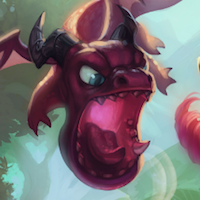Ask Riot gets a lot of questions about how we decide on your teammates and opponents in League, and we wanted to take some of the frequently asked ones and give them to the designers that work on matchmaking, champion select, position select, and all that good stuff. Let’s dive in:
Why do some games of League feel imbalanced?
When you encounter imbalanced games of League, we generally chalk it down to three major culprits: snowballing, matchmaking uncertainty, and/or perception.
In terms of design, we want League to be a game where getting a small advantage and running with it is one path to victory. Any small successes that are snowballed can determine early leads, and then sometimes the result of the game. Early Pantheon double kills can feel unstoppable without a miracle teamfight, but there’s always itemization and strategic calls that can turn games around from the brink of defeat.
.png?quality=80)
Within the actual systems, most teams have an expected win rate of 50 +/-1%. This means from all the data we have, we think we’ve made a fair match. But we can’t rely purely on the raw data. What if players are playing positions or champions they aren’t familiar with? What if there’s a large discrepancy in MMRs in a normal premade, or a player hasn’t played enough games to get an accurate rating (looking at you, smurfs)? On top of this, there could be personal factors that matchmaking can’t see—lack of sleep, one too many Graggy Ices, that sorta thing.
Depending on how you’re doing, it could just be your perception. Being wrecked is much more visceral than the joy of dominating your opponent, and the really bad moments can unfortunately be more memorable than the great ones.
And sometimes you’ll just have a bad game.
While we know our matchmaking systems are never going to be perfect, and sometimes you (or your opponent) will end up with a 20 minute win, we try everything we can to prevent imbalance before the game has even started, and consider it a huge priority to ensuring League remains competitive.
— Riot Gortok, Designer, Get in Game Team
Why do I get worse people in my games when I’m on a hot streak and trying to climb?
This is pretty much an urban myth. Mostly.
There’s nothing in the MMR system that forces you to have lower-skill teammates or disproportionately higher-skill opponents. We expect every game you play to have a 50 +/-1% chance of your team destroying the Nexus.
As your MMR goes up, you’ll stop being the “standout” player and your teammates’ skills will be higher. This can also happen to anyone else in the game, which can give the impression that you have “worse” teammates, when really they might just be newcomers to your skill bracket.
Even if it all goes wrong and you feel like your teammates have been letting you down, you can make use of systems like demotion protection and promo helper to prevent you from being punished for a few “unlucky” games. We think this is the right tradeoff compared to having a volatile rank—being demoted feels rough, and reaching a tier should be a decent indication that you can play at that level.
— Riot Gortok, Designer, Get in Game Team
Why do I come up against high-ranked players in unranked games?
MMRs between queues aren’t connected. This means occasionally high-MMR ranked players have lower MMRs in normals.
Our perspective on the queues is that ranked should continue to be where you put on your tryhard pants. In contrast, unranked queues should be a place to play and experiment in a less intense competitive setting. The reason the MMRs aren’t linked is that introducing a consistent connection could change the competitive intent of each queue.
For example, if having a higher ranked MMR meant you would be placed higher in normals, it could put more pressure on you to have a “ranked mentality” in all queues. Beyond this, we want to provide an outlet for experimentation and lower stakes through unranked modes. A player who tries super hard in ranked may play with their casual friends and try goofy strats in normals in a way that means they perform at a lower level.
That said, we think there’s room for improvement here. We’re looking into some options, such as having better algorithms to get players to more accurate MMRs in a shorter time, or potentially “splashing” small amounts of MMR from ranked into normals without a direct link between the two.
— Riot Socrates, Designer, Meta Game Systems
Why do I get matched with unranked players if I’m Bronze/Silver/Gold?
When players first start playing ranked, they have to go through a period of placement games where we try to figure out how good they are. We have to place them against players we already have a lot of information about to get the most accurate placement. Since most players are Silver and below, we tend to start looking in Silver and move them up or down based on their performance.
— Riot Gortok, Designer, Get in Game
Why do you continue to match me with players I block/mute/report?
Short answer: It would literally break matchmaking if we didn’t.
Imagine you’re Challenger in KR (congrats) and you come up against Faker in midlane. He dumpsters you, and your plays show up in a TOP FAILS montage on the Inven frontpage. Next time you see him in solo queue, you rage-check a box that says “don’t match me with this player.” Now imagine 100 more people do that this week.
.png?quality=80)
Matchmaking would have to look at players much further from your MMR because it’s unable to fill a lobby, your queue time would increase, and you’d end up being on consistently less-good teams. Players end up like a bunch of magnets constantly repelling each other—if enough of them misuse a feature like this (and it wouldn’t take many!), then fair matches would end up next-to-impossible to find.
— Riot Draggles, Comms Strategist, Meta Game Systems
Why does the system not use KDA and other similar stats instead of Elo/MMR systems?
League of Legends is a team game and teams win or lose games together. We don’t want to impose an arbitrary system of rating players on performance because then the best way to beat that system would probably be to get good scorelines, rather than helping the team win.
We want to reward good play that ultimately leads to a win, no matter how small their impact may seem. Supports sacrificing themselves to save their ADC, tanks zoning three enemies in a teamfight, or assassins diving the backline to blow up the carry are all examples of plays that may not make a great statline but help get the W. Some champions have unique playstyles (think Singed/Nunu) that would be tough to measure, and their mains may not be graded appropriately based on their play.
You should be rewarded for different types of achievement and impact, so we’re always looking at new systems to surface cool in-game plays (like vision score or unique missions) that aren’t necessarily reflected in KDA or win/loss ratios. We also want to try and give you ways to express mastery across different positions. What sorts of different ways would you like to see progression in League? Let us know!
— Riot Gortok, Designer, Get in Game
Why can’t I see my MMR?
We talked about this when we first released the Leagues system (holy crap, five years ago now). tl;dr: Showing MMR has a lot of downsides in a team-based game like League.
On the plus side, MMR is a more accurate summation of where you are in relation to other players across the entire server, and showing it can be more reassuring that the match you’re in is fair when scouting your opponents out before a game.
.png?quality=80)
Using MMR as the sole mark of achievement in League punishes half of the playerbase as their MMR will decline over the course of the season, which sucks because most of them are gradually getting better at the game—but so is everyone else around them.
Ranked tiers also provide contextual progression and status. Knowing you’re “a Gold player” as opposed to “a 1650 MMR player” or “120,353 on the server” gives you clearer targets to work towards. Moving from 1595 to 1600 MMR is probably not that compelling, but promoting from Silver I to Gold V should give you the knowledge that you’re truly improving.
The Leagues system also gives you a bit of protection from losing a bunch of games in a row and having your MMR plummet as a result. Using demotion protection and promo helper, you can get a few extra lives in rare cases of not getting your preferred position for a few games or just being in a slump. Ranked anxiety is real, and we know there can be a lot of pressure, so having meaningful progression that feels good should hopefully break down a few of those barriers.
— Riot Gortok, Designer, Get in Game
I’m in Master/Challenger and my MMR seems to be going down. One day I have favourable LP gains and the next I don’t. What’s going on here?
LP gains and losses are also based on your skill estimation compared to the players around you. This becomes most apparent at the Master/Challenger level, where there are only a few players and the competition for spots becomes very contentious. If you take a break from playing for a bit, the MMRs of the people around you are still changing, and that can result in notably different LP gains when you return.
For example, let’s say you grind to Challenger and bank games to lock your LP for 10 days, then go on vacation until your banked games run out. While you’re away, your MMR/LP is safe and static, but all those other Challengers (and Masters, and high Diamonds) are still playing games. This tends to slowly increase the average MMR at the high end of the ranked system. So when you come back from your hiatus, your MMR is right where you left it—but now the competition around you is even higher. When you play again, you’ll get lower LP gains and higher losses, as you are now slightly below the average for your ranking, but as you win a few games, those LP changes will return to normal.
— RiotIAmWalrus, Designer, Competitive
We got pretty technical here, but we hope this provided a little more context into matchmaking in League. What other questions do you want answered? Where do you feel we can improve our systems? Let us know in the comments!
This is the second post of a three-part update on matchmaking in League! Read the rest below:
Part 1: How does matchmaking work? – A much-needed update to the Riot Support article to better represent how matchmaking works in League in 2018.
Part 2: /dev: Matchmaking Real Talk – Answering some of the tough questions around matchmaking, and hopefully dispelling some myths along the way.
Part 3: /dev: Making Matchmaking Better (releases next week) – Take a look behind the scenes at some of the improvements we’ve been making for the last couple of years.

